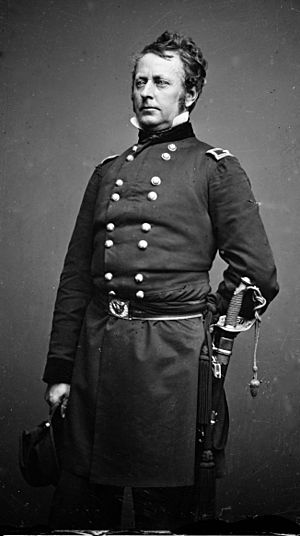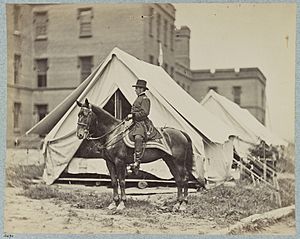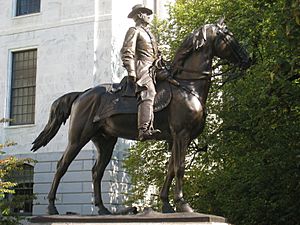Joseph Hooker facts for kids
Quick facts for kids
Joseph Hooker
|
|
|---|---|

Portrait by Mathew Brady or Levin C. Handy
|
|
| Nickname(s) | Fighting Joe |
| Born | November 13, 1814 Hadley, Massachusetts |
| Died | October 31, 1879 (aged 64) Garden City, New York |
| Place of burial |
Spring Grove Cemetery
|
| Allegiance | Union |
| Service/ |
|
| Years of service | 1837–1853, 1861–1868 (USA) 1859–1861 (California) |
| Rank | |
| Commands held | I Corps Army of the Potomac XX Corps Department of the East |
| Battles/wars | Seminole Wars Mexican-American War American Civil War |
| Signature | |
Joseph Hooker (born November 13, 1814 – died October 31, 1879) was an important officer in the United States Army. He became a major general in the Union Army during the American Civil War. Even though he served well in many battles, he is most remembered for his defeat by Confederate General Robert E. Lee at the Battle of Chancellorsville in 1863.
Contents
Early Life and Military Training
Joseph Hooker was born in Hadley, Massachusetts. His grandfather was a captain in the American Revolutionary War. Joseph went to school at Hopkins Academy. He then studied at the United States Military Academy and graduated in 1837. He was ranked 29th in his class.
After graduating, he became a second lieutenant in the 1st U.S. Artillery. His first job was fighting in Florida during the Seminole Wars.
Service in the Mexican-American War
Hooker also served in the Mexican–American War. This war lasted from 1846 to 1848. He worked for generals Zachary Taylor and Winfield Scott. He showed great leadership and bravery in three battles: Monterrey, National Bridge, and Chapultepec. Because of his actions, he was promoted to lieutenant colonel.
After the war, Hooker left the army in 1853. He tried to get elected to the California legislature but did not win. From 1859 to 1861, he was a colonel in the California militia.
Joseph Hooker in the Civil War
When the Civil War began in 1861, Hooker wanted to rejoin the army. His first request was turned down. He traveled east from California and saw the Union Army lose at the First Battle of Bull Run. After this, he wrote to President Abraham Lincoln. He explained his skills and asked for a position in the army again.
In August 1861, he was made a brigadier general. He led a brigade and then a division near Washington, D.C. He helped train the new Army of the Potomac under Maj. Gen. George B. McClellan.
The Battle of Chancellorsville
Hooker became the commander of the Army of the Potomac. He planned a bold attack against Robert E. Lee's army. However, his army was defeated by the Confederate Army at the Battle of Chancellorsville. Many soldiers were lost on both sides. About 17,000 Union soldiers and 13,000 Confederate soldiers were killed or wounded.
President Lincoln kept Hooker in command for a while. But when Hooker asked for more troops and was refused, he resigned his command. George G. Meade took over the Army of the Potomac on June 28, 1863. This was just three days before the important Battle of Gettysburg.
Later Civil War Service
Hooker returned to fighting in November 1863. He led two army corps to help the Union Army in Chattanooga, Tennessee. He won an important victory at the Battle of Lookout Mountain. This was part of the Chattanooga Campaign. He then served in the Western Theater under Maj. Gen. William T. Sherman.
Later Years and Legacy
After the Civil War, Hooker led Lincoln's funeral procession in Springfield in 1865. He commanded military departments in the East and near the Great Lakes. Later in his life, he had poor health and was partly paralyzed by a stroke.
He retired from the U.S. Army on October 15, 1868, as a major general. Joseph Hooker died on October 31, 1879, while visiting Garden City, New York. He is buried in Spring Grove Cemetery in Cincinnati, Ohio.
There is a statue of General Hooker on a horse outside the Massachusetts State House in Boston. Also, Hooker County in Nebraska is named after him.
Images for kids
-
Major General Joseph Hooker, 1862. From the Liljenquist Family Collection of Civil War Photographs, Prints and Photographs Division, Library of Congress. Photograph by Mathew Brady
See also
 In Spanish: Joseph Hooker (militar) para niños
In Spanish: Joseph Hooker (militar) para niños












